A combined effort by U.S. Central Command and the Royal Jordanian Air Force provided additional humanitarian aid to northern Gaza on Tuesday.
“Three U.S. C-130s dropped over 36,800 meals into northern Gaza to provide critical relief to civilians there,” said Pentagon Press Secretary Air Force Maj. Gen. Pat Ryder during a briefing this afternoon. “This is the second combined airdrop to deliver humanitarian assistance to the people of Gaza.”
The first such humanitarian mission occurred Saturday when the U.S. and Jordanian forces airdropped 38,000 meals along the coastline of Gaza, Ryder said.
“These humanitarian airdrops contribute to ongoing U.S. government efforts to provide life-saving humanitarian assistance to people in Gaza and are part of a sustained effort to get more aid into Gaza, including by expanding the flow of aid through land corridors and routes,” Ryder said. “We continue planning for potential follow-on airborne aid delivery missions.”
Also today at the Pentagon, Secretary of Defense Lloyd J. Austin III met with Minister Benny Gantz, a member of the Israeli war cabinet. Among topics of discussion during that bilateral meeting was humanitarian assistance in Gaza.
“The secretary … expressed strong concerns over the humanitarian situation in Gaza and requested Minister Gantz’s support in enabling more humanitarian assistance and distribution into Gaza,” Ryder said.

Pentagon Press Secretary Air Force Maj. Gen. Pat Ryder conducts a media briefing at the Pentagon, March 5, 2024. © Joseph Clark
One way Israel can assist in helping more aid to get to Gaza, Ryder said, is to ensure availability of a ground route, such as at the Kerem Shalom checkpoint in southern Gaza.
“Not enough aid is getting into Gaza. And so, the Department of Defense is supporting that broader U.S. government effort to help contribute to that,” Ryder said. “Certainly, we want to see more aid being delivered via ground routes. And again, this is part of the discussion that we’re having with the Israelis in terms of how [they can] work to ensure that those routes are open, and that aid can get in quicker.”
While the U.S. has provided humanitarian assistance to Gaza via airdrop, Ryder said the U.S. is exploring other options — including supporting delivery of assistance to Gaza by sea.
“In coordination with the U.S. interagency and international partners, we are actively reviewing options for a maritime corridor for humanitarian assistance into Gaza,” Ryder said, adding that this includes potential commercial and contracted options.

A C-130J Super Hercules loaded with humanitarian aid pallets rigged with parachutes for airdrop takes off from an undisclosed location in Southwest Asia, March 5, 2024. The humanitarian assistance package included 60 pallets of U.S. and Jordanian aid to provide sustenance to civilians lacking access to a reliable source of food due to the ongoing conflict in the region. © Air Force
A “maritime corridor” to provide humanitarian assistance to Gaza involves ensuring a secure and safe route through the Mediterranean. U.S. involvement in such an endeavor, Ryder said, would be in providing support to the effort, rather than having U.S. forces go ashore.
“At this point in time, there are no plans to send any U.S. forces into Gaza,” Ryder said.





